- News
- Reviews
- Bikes
- Accessories
- Accessories - misc
- Computer mounts
- Bags
- Bar ends
- Bike bags & cases
- Bottle cages
- Bottles
- Cameras
- Car racks
- Child seats
- Computers
- Glasses
- GPS units
- Helmets
- Lights - front
- Lights - rear
- Lights - sets
- Locks
- Mirrors
- Mudguards
- Racks
- Pumps & CO2 inflators
- Puncture kits
- Reflectives
- Smart watches
- Stands and racks
- Trailers
- Clothing
- Components
- Bar tape & grips
- Bottom brackets
- Brake & gear cables
- Brake & STI levers
- Brake pads & spares
- Brakes
- Cassettes & freewheels
- Chains
- Chainsets & chainrings
- Derailleurs - front
- Derailleurs - rear
- Forks
- Gear levers & shifters
- Groupsets
- Handlebars & extensions
- Headsets
- Hubs
- Inner tubes
- Pedals
- Quick releases & skewers
- Saddles
- Seatposts
- Stems
- Wheels
- Tyres
- Health, fitness and nutrition
- Tools and workshop
- Miscellaneous
- Tubeless valves
- Buyers Guides
- Features
- Forum
- Recommends
- Podcast
feature
 BOTY201617super-img.jpg
BOTY201617super-img.jpgroad.cc Superbike of the Year 2016-17
Bianchi, Canyon, Cannondale, Specialized, Giant, Pinarello, Merida, J.Laverack, Storck and Look
We’ve reviewed a lot of superbikes here on road.cc over the past 12 months – cutting-edge bikes with huge price tags – and here are the very best.
How does a bike get onto our list? First, it has to have been reviewed on road.cc over the past year. If we’ve not had it in, it doesn’t go on. Simple.
Second, it has to have a price tag of over £3,500. That’s an arbitrary figure. We could have made the cut off £3,000, £4,000, or anything else, but we chose £3,500 this year.
If a bike fulfils these first two criteria it’s up for consideration. Beyond that, it has to put in a serious impressive performance. We’re also looking for technical and engineering innovation and smart design features that lead to an improved performance out on the road. Tech for tech’s sake doesn’t count for anything, we’re all about the ride.
All of the bikes here have a little something extra too, something that elevates them above being just very good and into superbike status. Lots of bikes out there do their jobs very well, but the bikes below really make us want to keep coming back for more.
One thing we don’t take into account in the road.cc Superbike of the Year is value. This is a money-no-object category. If you’re interested in looking at value, click on the link to the full review at the end of each entry on our list.
In short, this is a rundown of the high-end bikes that have impressed us most during testing over the past year, with value taken out of the equation. With all that sorted, let’s get stuck in…
10. Look 795 Aerolight £4,449.99 (frameset)
The Look 795 Aerolight is an innovative, swift and fast reacting aero road bike.
This is a very accomplished bike that feels most alive when you're soloing off the front of the group or riding fast over flat or rolling terrain. It offers a whole lot of speed for your efforts and maintains that pace well.
Although the 795 Aerolight isn't quite up there with the absolute best when it comes to accelerating out of a tight corner or getting on the wheel of an attacker, it still sweeps up to speed quickly enough to leave most others working hard to keep up.
There are plenty of lighter bikes out there for this kind of money but the 7.7kg (17lb) of our review bike does include Look's own pedals. Take that into account and it's pretty light, especially for an aero bike fitted with 52mm rims. The 795 Aerolight doesn't quite spring up the slopes but it's certainly up for the fight, impatient to get back to the higher speeds where it can really impress.
The mid-section of the bike feels notably strong when you turn up the power thanks to a huge bottom bracket shell and Look's Zed 3 chainset that's a '100% carbon monobloc construction'. In other words, the two crank arms and the axle are made as one piece, and they feel like it, providing a concrete-hard platform when you hit the pedals with everything you can muster.
The 795 Aerolight feels like many other race bikes in that the ride is on the firm side, but elastomers on Look's own E-Post 2 – the topper on the integrated seatpost – absorb a lot of vibration from the road. You don't climb off this bike at the end of a long ride feeling like you've taken a kicking.
The frame tubes are made to NACA (National Advisory Committee for Aeronautics) aerofoil profiles. This applies to the seat tube, the down tube, the head tube, the seatstays and the fork – so pretty much everything, then.
The deep seat tube is cut away around the rear wheel in tried and tested time trial manner, and you get an integrated seatpost here so the aero shaping extends uninterrupted almost up to the saddle.
Rather than using a standard stem clamped to the steerer tube somewhere above the top of the head tube, Look has taken a chunk out of the top of the head tube and sunk its hollow, high modulus carbon fibre Aerostem into the step this creates. The stem sits flush with the sloping top tube, a rubber cover making the transition between the two even smoother.
Why it’s here An innovative aero road bike that delivers plenty of speed
9. Storck Durnario Platinum £8,250
Storck's Durnario Platinum is the German company's lightweight endurance bike, and at 6.4kg (14.1lb) and with a buttery smooth ride it delivers on both fronts.
The first thing that strikes you about the Durnario Platinum is how smooth and refined the ride is. It's outstandingly supple, soaking up all the ripples and imperfections of even the most badly surfaced British roads. There are no gimmicks or tricks here, no decoupled seat tubes, rubber inserts or suspension dampers, instead just a simple reliance on wide tyres and cleverly shaped tube profiles and carbon fibre layup.
It's agile and very sporty. The balance of the bike is good, and the low stance of the geometry, which has more in common with a race bike than most endurance bikes, puts you in an attack position that promotes rapid progress. The steering feels well weighted, with a level of response not normally found in an endurance bike.
On short, fast rides you get all the pace and control you'd expect from a race-ready bike. Its low weight is a real benefit on long, gradual climbs and the stiffness of the frame is evident on steeper escarpments, though front wheel flex did result in occasional brake rub. For tackling really long and hilly rides on long-distance outings, this bike was a flattering partner.
Despite the low weight, there's no jumpiness or skittishness to the way it handles fast descents or high-speed corners. It's very stable and has a reassuringly planted feel that massages your confidence to happily propel the Durnario along at rapid speeds. Through fast descents, it is rock solid and lets you take some liberties through the turns.
Key details of the new bike include space for up to 32mm tyres and the use of specially shaped tubes, and particular attention paid to the carbon fibre layup to provide improved rider comfort. Storck calls the tube shaping Directional Depending Stiffness, and the simple idea is that the tubes have been engineered to provide some vertical deflection, or flex, while maintaining a high lateral stiffness.
Despite these concessions to comfort, the Durnario still carries the Storck hallmark of being incredibly light. The frame is a claimed 790g and the fork is 280g. That's as light as many WorldTour race bikes that aren't designed for comfort or able to take wide tyres. The complete bike weight as tested was just 6.4kg, making it one of the lightest bikes to pass through the road.cc office.
With its lack of mudguard mounts and disc brakes, the Durnario doesn't offer the practicality and all-weather dependability that other endurance bikes do, but it's one of the finest and smoothest road bikes out there. For conquering long days in the mountains, gran fondos and sportives, the Storck Durnario Platinum is a top choice.
Why it’s here Stunningly light endurance ride wth race bike handling
8. J.Laverack R J.ACK III £6,200
The new R J.ACK from young Rutland-based company J.Laverack combines the classic titanium appearance with a ride that is wonderfully smooth and entertaining when you up the pace.
You’ll soon notice that the J.ACK is something special. Many words get slung about when people start rhapsodising about the virtues of titanium, the most frequent being 'springy'. J.Laverack has produced a frame that retains the inherent liveliness of the material, but has increased the rigidity just enough to produce a very sharp-riding race bike. With the stout feeling amplified by the stiff Enve carbon fibre fork and oversized tubes, the result is a bike that feels alert and direct. But it also retains the smoothness that draws many cyclists away from carbon and aluminium to titanium.
It's an exciting, fun and confidence-inspiring bike to ride. It has a ride quality that surpasses that of many carbon frames. Where good carbon frames can damp the road surface beneath you in a brutally efficient manner, titanium relays just enough of the surface while filtering out the harshness, to provide a lively and entertaining ride.
The wheels seem to follow the contours of the road surface rather than crashing in and out of dips. Nowhere is this better felt that on fast descents with a variety of road surfaces to deal with – it's planted at high speed and feels secure through the bends.
It's a bike that lets you really climb, sprint, chase, surge and plummet to your full potential. It promotes confidence, never getting nervous or twitchy. You can exploit its nimbleness through challenging corners, and the weight – albeit a small penalty over an equivalent carbon bike – doesn't detract from the ride. Let's face it, 7.5kg isn't exactly heavy. And on the climbs, the stiff front end comes into play and really lets you lean on the handlebar and wrestle the R J.ACK up any steep gradient.
While it's billed as a race bike, and it will surely suit performance-minded cyclists, it's a better match for someone wanting a comfortable and smooth bike for tackling long distances rides.
Why it’s here A thoroughly enjoyable and fast riding titanium road bike from a new British bike brand
7. Merida Scultura Disc Team £6,500
Our man Jez loved the Merida Scultura Disc Team when he reviewed it back in September, calling it a superb example of the emerging disc-braked race bike category. It’s an entertaining partner for maximum-effort rides, but carefully tuned so it won’t beat you up on long rides, as befits a bike intended for professional racing.
Merida has two versions of the carbon fibre frame used for the Scultura disc: the CF4 and the CF2. This, the CF4, is the lightest (with an impressive claimed weight of 900g) and has the most aggressive geometry.
While the Reacto is the aero bike in Merida's range, quite a bit of work has been done to improve the slipperiness of the Scultura, with NACA "fastback" tube profiles used to offer an aerodynamic benefit without overly deep frame sections.
Merida has used a push-fit BB386 bottom bracket as well as thru axles front and rear to maximise rigidity under power, and we had no issues with creaking.
The Scultura Disc Team is super reactive. It's great fun to hustle on twisty roads, with the ample tracking stiffness giving you bags of confidence to hit the apex and smash it out the other side.
This is a bike that feels like it converts all of your input into action. Whether that's mashing the pedals on a hill or in a sprint for the town sign, or just threading a series of bends on a twisty backroad, the Scultura is game for whatever you've got.
But that would make it a tiring companion for an all day ride, right? Well, no. The bigger volume of the 28mm tyres and the long, unbridged seatstays combine to provide a decent level of comfort for a race rig. Some carbon bikes can be a bit rattly over broken tarmac, but Merida have managed to imbue the Scultura with a pleasingly damped feel on rougher surfaces.
This top-end model is fitted with Shimano Dura-Ace Di2 shifting, although not the complete groupset. The derailleurs, cassette and chain are from Shimano's top gruppo but that's it. The brakes are the non-series flat-mounted RS805 callipers, rather than the new Dura-Ace model launched earlier this year, operated by the ST-R785 shifters. The brakes, Dura-Ace or not, are simply brilliant.
Dura-Ace Di2 shifting is flawless. Shifting under power is serene, and without the spectre of a botched shift there's no reason to stay in a gear any longer than you need to, keeping your cadence exactly where you want it.
The Merida Scultura Disc Team is 7.73kg (17lb) so it’s fairly weighty for a bike of this price, but don’t discount it because of that. It still feels like a fast race bike on lumpy, rolling terrain and long, draggy climbs.
Why it’s here High-octane race bike with peerless shifting and braking - a scintillating pro-level ride
6. Pinarello Dogma F8 £8,250
The Pinarello Dogma F8 is the latest in a long line of Dogma models, but with a focus on aerodynamics it is the biggest departure from what has come before, the result of a development programme that pulled in much expertise from Team Sky and technical partner Jaguar.
With its aero shaped frame and fork, low weight, deep-section carbon wheels and integrated aero handlebar, the Dogma F8 is certainly quick enough, but it's the way it delivers that speed that is most impressive. There's an immediacy to its response with absolutely no lag or flex noticeable when you stamp on the pedals.
But it's not all about speed. The Dogma F8 is fun and involving. It's agile and nimble, with a lovely balance in the way it steers and responds. Enhanced by plenty of grip from the excellent Continental tyres, the high level of precision makes steering it through bends a hugely enjoyable experience, and has you seeking out the best swooping bends in the area.
It's far from the smoothest ride – in fact it's quite firm – but the 22mm tubular tyres (not my first choice) at 90psi provided a ride that held back from being harsh on rougher surfaces. Just occasionally on very fast descents on broken roads, the ride can verge on erratic, but it never gets out of control, remaining composed on flat and bumpy roads – I can best describe it as involving. If t's comfort you seek, Pinarello's Dogma K8-S might be a better bet.
This isn’t a bike for cruising along admiring the countryside. Give it your full and undivided attention and it rewards: it flows through corners beautifully, flies up climbs with the pace you'd expect of a stiff and light race bike, and descends with all the quality of the very best road bikes.
The Dogma F8 has been totally reworked from the previous version (which Bradley Wiggins won the 2012 Tour de France on) with a focus on aerodynamics and weight. It has a pretty narrow and extreme focus, as you'd probably expect of a bike developed to help Team Sky win races. This is a bike for riding fast on, and it delivers speed by the bucketload. If targeting PBs and training to be in the winning break of a race are your motives, then the F8 will suit you just fine.
The fit and riding position is as low and extreme as you'd expect of a race bike, but that's not enough to detract from the outstanding level of speed, stunning power transfer, nimble handling through the corners and stability at high speeds that the Dogma F8 offers.
Is it really as good as the badge and hype suggest? Yes. As for the price, it's possible to get most of what the Dogma F8 offers in a much more affordable package, but there are few bikes out there that come close to accurately replicating its overall performance.
Why it’s here This Tour de France winning bike offers incredible speed, performance and handling
5. Giant TCR Advanced Pro 0 £3,899
The Giant TCR Advanced Pro 0 is a marvellous race bike that's been redesigned to be a little lighter than before yet just as stiff.
When you jump on the TCR, the first thing you notice is just how solid it feels when you put the watts in, particularly through the centre of the bike. There's virtually no side-to-side movement here, certainly not when you're seated.
Get out of the saddle to maximise your power or chuck the bike about on a steep climb and the whole thing feels impressively strong and rigid. That's all the more surprising because the TCR doesn't look the most burly frame in the world. Giant has slimmed down the tubes noticeably but it can still handle everything we could summon up.
Giant says the rigidity is down to what it calls its Powercore design: an oversized bottom bracket/chainstay area with an 86mm-wide BB and asymmetric chainstays. Then there's the MegaDrive down tube. It's rectangular in section and is the part of the frame that most looks like it means business.
The front end is equally robust. Giant uses oversized bearings at both the top (1 1/4in) and the bottom (1 1/2in) of the head tube. The lower bearing has been moved very slightly higher in the head tube so it's more inline with the down tube, designed to improve the transfer of force to the frame.
The tapered head tube and the fork steerer keep the bike tracking beautifully when you hit the corners hard and fast, and the knowledge that you're going to get the performance you want allows you more options when duking it out close to other riders.
Climbing is another strength. Our complete bike in a large size weighed 6.83kg (15.1lb) and it scales the heights with a real energy. It feels like it's working for you on the slopes, egging you on, rather than a dead weight that you're dragging uphill against its will.
Giant has given the TCR Advanced Pro a new Variant seatpost that’s designed to improve the ride quality. The frame is built to Giant's Compact Road Design with a sloping top tube so you're likely to have plenty of that seatpost extending out of the frame. The result is that you get quite a bit of movement at the saddle to help deal with second-rate road surfaces. And third-rate ones, come to that. The TCR Advanced Pro doesn't isolate you from road bumps and vibrations to the same extent as some other road bikes out there, but for a race bike it's pretty smooth.
This bike is fitted with components from Shimano's top-level Dura-Ace groupset, with mechanical rather than electronic shifting. Dura-Ace is excellent across the board, the braking a particular highlight.
Why it’s here This is an exceptionally good race bike that combines stiffness, a light weight and a really strong spec
4. Specialized Venge ViAS Expert Disc £3,900
If you enjoy riding fast and want an aero bike but you also want the best brakes in the business, the Specialized Venge ViAS Disc could be for you. It's fast and agile, stiff and responsive, and the brakes offer excellent control.
This is a highly impressive bike. Is it fast? Yes, it's very rapid. It holds high speeds in the way all good aero bikes do.
The Venge ViAS Disc is precise and direct, with the front end displaying a high level of stiffness, especially noticeable when you're sprinting out of the saddle. Specialized has kept the wheelbase short and this provides plenty of agility, making the Venge a very playful, nimble bike through the twists and turns.
It's an absolute blast on the descents, too. It's not just when you're battering into a headwind that aero bikes provide an advantage, they are quick downhill as well. The powerful but easy to modulate hydraulic disc brakes and the stiffness of the frame and fork combine to create a bike that is easy to handle at high speeds.
While aero bikes are not designed for comfort – it's probably right near the bottom of the list of design objectives – it is remarkable just how smooth the Venge is. It's no magic carpet ride, and it's firmer than many other road race bikes, but it is surprisingly forgiving. There are occasions when it loses a bit of composure, but most of the time it's nothing but steady and planted.
The riding position is aimed at racers, but the 170mm head tube on this 56cm bike means it's not as aggressive as other aero race bikes. While top-end Venge bikes come with the company's own negative 17-degree stem to minimise drag and provide a lower front end position, this model comes with a regular stem. Finding it too short and high, we swapped it for a 120mm negative rise stem, shuffled the steerer tube spacers above the stem, and managed to get a suitably racy position that felt much more in keeping with the Venge's speedy intentions.
Adding disc brakes to an aero bike – a bike designed for all-out speed – might seem counterintuitive but we found the superior braking performance gave more confidence at the high speeds you can reach on the Venge. You can brake later into corners and you gain a bunch of extra confidence on steep descents. Plus, disc brakes are simply better in the wet.
According to Specialized, the Venge Disc is less than 4 seconds slower over 40km at 40kph than the rim-braked version, but that figure increases up to 8 seconds when the wind is coming at higher yaw angles. Clearly, there is a bit of extra drag generated by the disc brakes, but it's marginal. Away from the wind tunnel and in the real-world, the differences are so small as to be almost impossible to detect.
At 7.8kg (17.2lb) the Venge ViAS Disc is a respectable weight. There's a small weight penalty with the discs but it’s not massive. You can certainly get a lighter bike for this sort of money, and if climbing speed is all you're interested in, well, maybe this isn’t the bike for you. Everywhere else the weight isn’t a factor.
Why it’s here Very fast with excellent brakes, the Venge ViAS Disc could be a glimpse of the future...
3. Cannondale SuperSix Evo Hi-Mod Dura Ace 1 £3,999
The new version of the SuperSix Evo retains the accessible performance and solid handling of its predecessor but it's now that little bit better: lighter, stiffer, more comfortable and more aerodynamic. Carbon race bikes don't get much finer than this.
The new Evo remains true to its roots, but it's been refined and finessed. It retains the comfort and stiffness of the original but it's also a bit more aerodynamic.
The bike offers a dialled geometry that makes the handling one of the standout features. It responds quickly to your inputs, whether through the handlebar or pedals, but perhaps the most noticeable benefit of the changes is an improvement in the comfort and composure the bike displays on rough roads.
The old Evo was hardly a compromising and jittery bike on the rough, but the changes to the fork and a skinnier seatpost do bring about a noticeable improvement in compliance. It's that little bit more composed and it mops up vibrations in a much more assured manner than previoiusly.
Considering that it's a race bike, it's not overly flighty or ever twitchy, and is very stable and planted. This makes it an easy bike to get on with; there are no surprises, and it's right at home in a tightly packed peloton or leisurely Sunday jaunt. The front end feels a bit more direct than the previous model while also feeling smoother, and it tracks any line you care to choose with great accuracy.
Weight savings are too minimal to detect, but in this 6.4kg (14.1lb) Dura-Ace build, the Evo certainly isn't heavy and goes up climbs like a scalded cat, with the stiffened frame and fork making it a bit sharper when grunting up a wall of a climb out of the saddle. The gearing is spot-on, high enough to race on but low enough to tackle most steep gradients, and when you do run out of gears the low weight helps you out enormously.
Cornering and descending performance were highlights of the previous bike and continue to be on the new Evo, but the changes to the frame make it a more polished descender, smoother through rough turns, with slightly more direct steering. It's an easy bike to pilot down a descent at high speed, and you can get pretty close to the limits while remaining calm and collected.
Why it’s here Lighter, stiffer and more aerodynamic, Cannondale's new SuperSix Evo is a worthwhile update
2. Canyon Ultimate CF SLX 9.0 £3,599 (now £4,099, revised spec)
Wow! Bang for buck, you'll struggle to find a better race machine than the Canyon Ultimate SF SLX 9.0. But even taking value out of the equation – as we do for Superbike of the Year – you'll be hard pressed to beat the weight and performance of the German company's 'all-round' racer.
Canyon has concentrated on aerodynamics with the new Ultimate and it certainly feels quick sitting at a steady 25mph on the flat, smooth tarmac. It's not aerodynamic in a way that Canyon's Aeroad is but the Ultimate makes a good compromise.
Twisting B-road descents are an absolute joy. The bike is so stable and composed no matter what the speed with the tiniest of inputs keeping the Canyon exactly where you want it.
Canyon has actually ditched the oversized tapered head tube on this new model for aerodynamic reasons, going for matching diameter bearings top and bottom. They are still a pretty meaty 1 1/4in diameter so this hasn't impacted on front end stiffness at all.
With a weight of 6.5kg (14.4lb) the Canyon isn’t going to give you any problems on the ascents. Shimano's 11-28 toothed cassette range gives a pretty low climbing gear when paired with the semi-compact 52/36 chainset – pretty low for a race bike at least.
Stiffness through the wide press-fit bottom bracket junction is impressive, as is the front end, so every pedal revolution you put out gets delivered to the road whether you're in or out of the saddle.
The only fly in the ointment is the Mavic Ksyrium Pro Exalith SL wheelset. It’s a phenomenally light set of aluminium race wheels, but we could get a good deal of brake block rub due to flex when really putting the power down.
Changing the standard style seat clamp for an integrated version has left an amount of seatpost exposed from the frame, which will then flex under load. At times you can really feel it flexing, which can be a little disconcerting, especially when you first ride away. What it means from a riding point of view is that you never suffer from any muscle fatigue or soreness from being battered by rough roads.
The fork legs allow a bit of fore and aft to control vibrations at the front end, and while the bike still feels direct and stiff, the bangs and crashes don't make it through to your hands or forearms.
Although £3,599 isn't cheap, it's not often you can ride a frameset straight from the pro peloton with a full Shimano Dura-Ace groupset and £1,000 Mavic wheels for such a good price.
Why it’s here This bike puts in stunning to balance stiffness and comfort, and stability and excitement
1. Bianchi Oltre XR4 Super Record £9,500
The road.cc Superbike of the Year 2016-17 is the Bianchi Oltre XR4, a lightweight race bike that puts in a superb performance. It's agile and mega-stiff with pin-sharp handling, and it's comfortable enough that you can thoroughly enjoy long rides rather than counting down the miles until it's time to get off.
The Oltre XR4 is the latest Bianchi model to get Countervail technology, Countervail being a viscoelastic material that’s embedded within the carbon-fibre structure of the frame and fork. The idea is to cancel vibration while increasing stiffness and strength.
We can’t say for certain how much influence the Countervail has outside the lab and on the road but we can tell you that the Oltre offers a ride with a marked absence of vibration. Everyone who rode our review bike said the same thing unprompted. There's just a bit less flutter than usual coming though the contact points.
Bianchi has updated the shapes of the frame tubes over those of the Oltre XR2 as a result of CFD (computational fluid dynamics) and flow visualisation. Bianchi says the XR4 has a '20 watt power gain' over the XR2 at 50km/h (31mph). In other words, the power needed to hold 50km/h on the XR4 is 20 watts lower than the power needed to hold 50km/h on the XR2. Five watts of that is down to the new Vision Metron 5D combo handlebar/stem while the frame is said to be worth 15 watts (bear in mind that even the pro peloton doesn't average 50km/h).
Some high-end aero bikes can flex quite a bit as manufacturers shed grams but Bianchi hasn't made that mistake here, and this is a lightweight bike. Our complete 57cm model hit the road.cc Scales of Truth at 6.53kg (14.4lb). Once you've added pedals, that puts it round about the UCI's minimum weight limit for racing.
The Oltre XR4 feels superbly efficient around the bottom bracket despite its low weight. It's a similar story up front where the steering is excellent, giving you the courage to slam the bike hard into corners and jump about in a group of riders knowing that you'll end up exactly where you want to be. No sketchy reactions, no dicey moments, just fantastic handling whatever the situation.
The Bianchi Oltre XR4 really is a superb bike, picking up where its predecessors left off. It's lightweight, reactive and very smooth, and if Bianchi's claims are to be believed, it's highly aerodynamically efficient too. If you have money in your pockets and racing on your mind, this is one of the very best.
We reviewed a super high-end version of the Oltre XR4 with a Campagnolo Super Record groupset and Campag’s Bora Ultra 50 Dark wheels. There’s no such thing as a cheap Oltre XR4 but complete bikes start at £4,700.
Why it wins The Oltre is lightweight, quick to react and very, very smooth; this is a superb pro-level race bike
Mat has been in cycling media since 1996, on titles including BikeRadar, Total Bike, Total Mountain Bike, What Mountain Bike and Mountain Biking UK, and he has been editor of 220 Triathlon and Cycling Plus. Mat has been road.cc technical editor for over a decade, testing bikes, fettling the latest kit, and trying out the most up-to-the-minute clothing. He has won his category in Ironman UK 70.3 and finished on the podium in both marathons he has run. Mat is a Cambridge graduate who did a post-grad in magazine journalism, and he is a winner of the Cycling Media Award for Specialist Online Writer. Now over 50, he's riding road and gravel bikes most days for fun and fitness rather than training for competitions.
Latest Comments
- froze 52 min 51 sec ago
I guess what is disturbing is that the average price of tires are getting far out of the realm of reasonable. Even with these 7 tires the average...
- Veganpotter 1 hour 5 min ago
Love my Lights and Motion lights. But it's not 2010 anymore. Many Chinese lights are better for half the money, without safety issues. Keep in...
- froze 1 hour 14 min ago
What ad marketing company did they hire? Was it a elementary school project?...
- Smoggysteve 1 hour 51 min ago
It's difficult to try and have the moral high ground when your choices are Chinese produced product sold by China vs Chinese produced product sold...
- Ashok C 3 hours 8 min ago
Enjoyed the humour in your write up. Stunning paint job too. Loved the glasses will provide" "a better view in the peloton." Cheers!
- Daclu Trelub 3 hours 42 min ago
Glad to see the BBC is still doing a bang-up job of alienating left and right in equal measure. Keep up the good work, Auntie.
- Secret_squirrel 4 hours 26 min ago
I don't think that entirely fair. A whole new range of gearing options and an entirely new model that shares virtually nothing with the others....
- rct 4 hours 37 min ago
I didn't realise X / Twitter still had 37 users!
- mdavidford 5 hours 27 sec ago
You put a (not really a) hashtag on it - that automatically qualifies it as a rant.


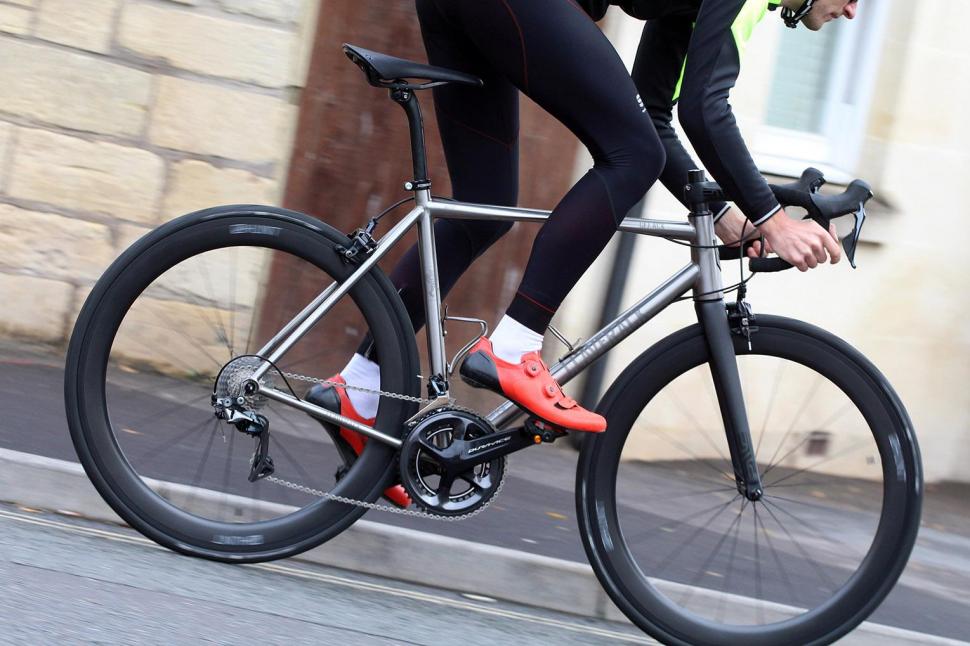
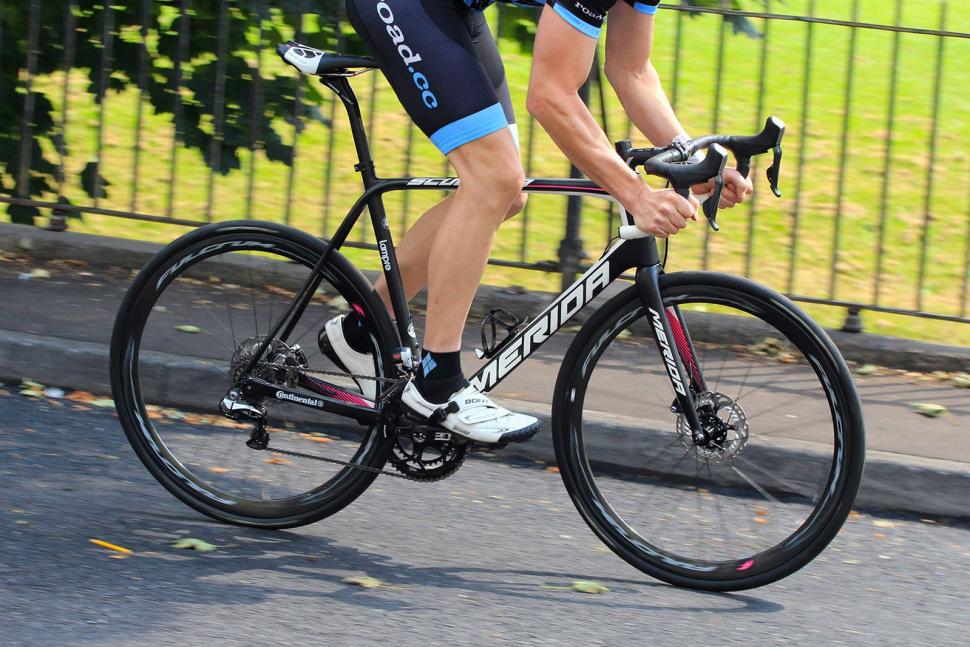

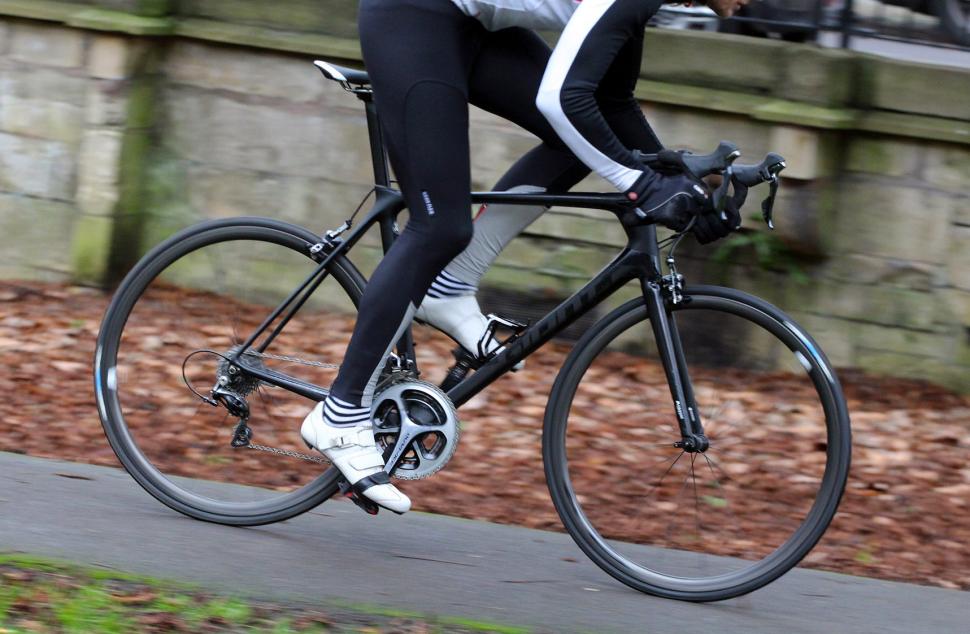
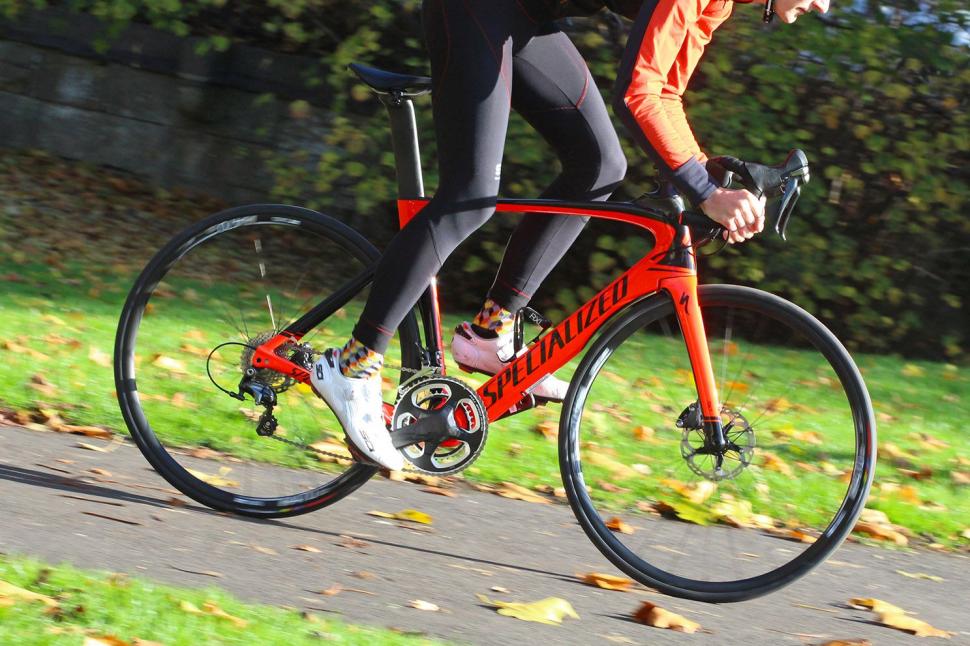
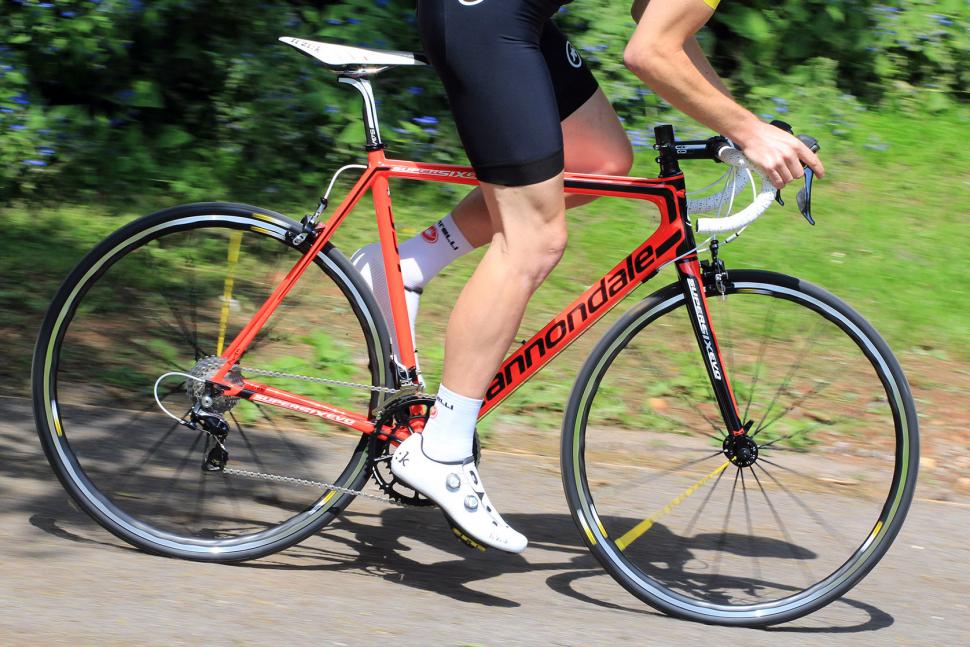
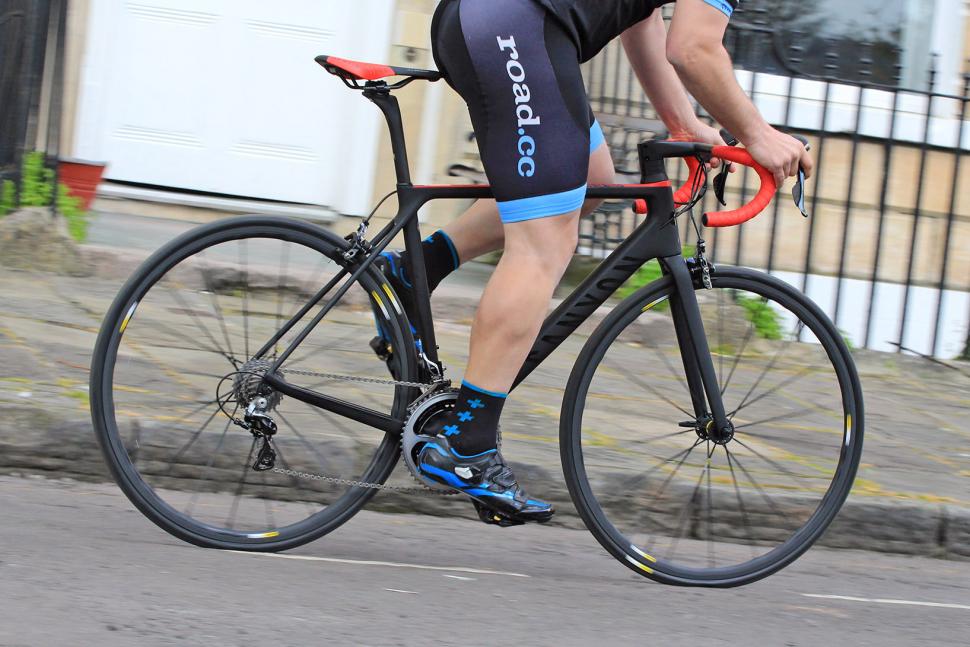
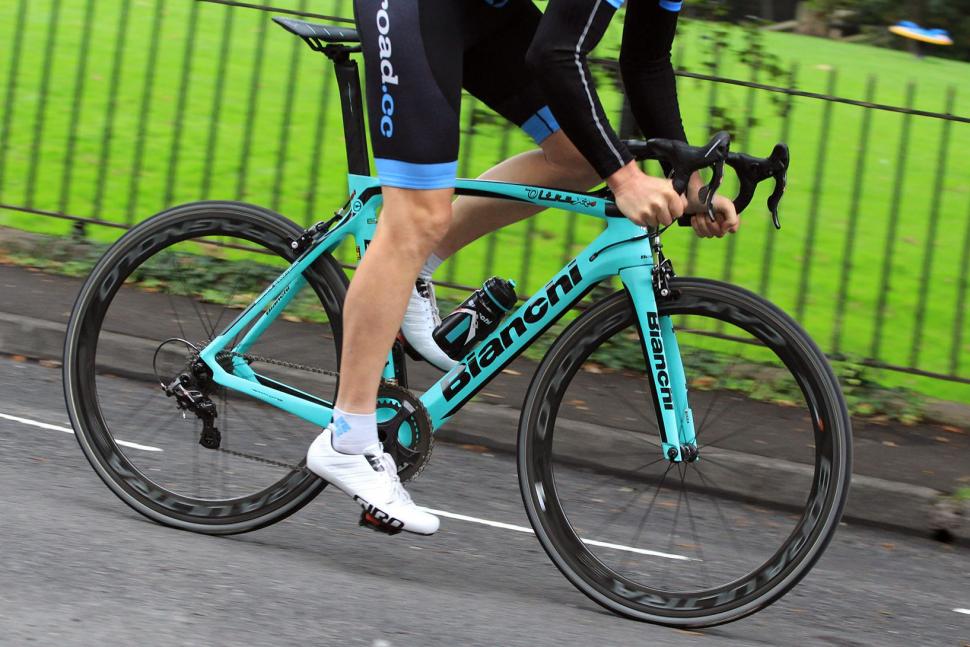
Add new comment
14 comments
How come all of the bikes above have weights listed in your write ups except the Pinarello?
Comparing subjectively between various ti, carbon and steel bikes I've owned running tyres 23-28, the CV frame descends on rough tarmac the smoothest whilst feeling the most connected to the road , while running 25s. So I'm not sure CV's a gimmick and at around 700gms for the frame I can't imagine the CV is adding very much weight. But it's a way of making your frame stand out in a crowded market place and charging more.
Love the Bianchi, I just can't get past the celeste colour
You can get it in other colours, though I can't understand why you'd want to
Countervail is hardly a gimmick. My Infinito CV is definitely a more comfortable ride than my previous bikes. Especially on rides over 100Km.
Also, was the F8 released in 2016 or 2015? With the release of the F10 this week I was wondering where the F9 went?
How do you know it's the countervail and not the frame design? Loads of modern endurance frames are just as or more comfortable now without it. I have an Infinito CV too.
I have some experience here. My Oltre XR4 and Infinito CV are definitely in a different class comfort-wise. I have a close friend with a Speciallisimo (and other top end bikes) and also speaks very highly of the unique feel of his Bianchi. Countervail is the common denominator here. I also have a Cannondale EVO Hi-mod (2015) which is an excellent point of comparison since it too is a pretty highly regarded frame.
Hmm, but then we're prone to confirmation bias - myself included. I've got an Infinito CV and a Focus Cayo from 2010. When they were both on 25mm tyres I honestly couldn't tell much of a difference between them over 60-80 miles (believe me I wanted to!) But putting 28mm tyres on the Infinito made an appreciable difference.
Tyre volume makes by far the biggest difference in comfort. The rest of it is so much marketing jazz.
Always surprised how Focus never get in these lists. I am biased having the Cayo and Izalco but every review places them at the top ...
I absolutely agree, they are well built, look great, and are reliable, but are also subtle, which works for me perfectly.. maybe that's why they're not the superstar manufacturer which attracts all the attention
Can't argue with the winner. No review of the Wilier Zero 6 mind. Their limited edition was the nicest looking bike released last year in my opinion.
Imagine how light Bianchi could make the XR4 if they dropped the countervail gimmick. Actually, goes to show, the aero bike v lightweight bike choice is highly contrived at the current generation of frame building. We could all be rolling around in 6KG aerolight bikes if the industry and UCI wanted it.
Dogma should be struck off the list purely because of that weird fork/headtube mismatch
I can see where you're coming from, but I quite like it for some reason. it helps to blend the front brake with the frame